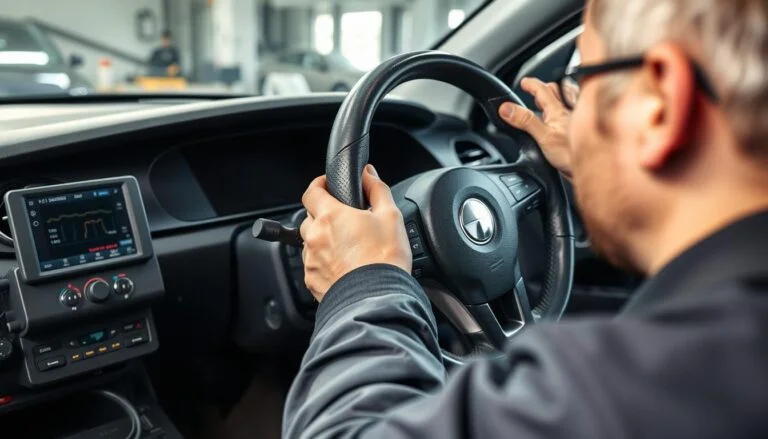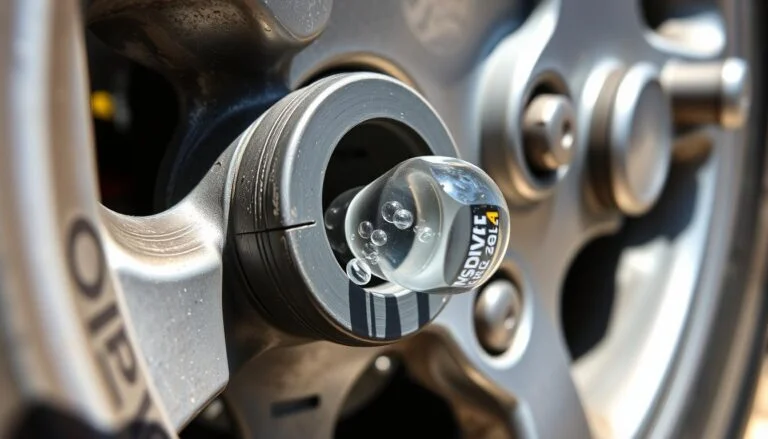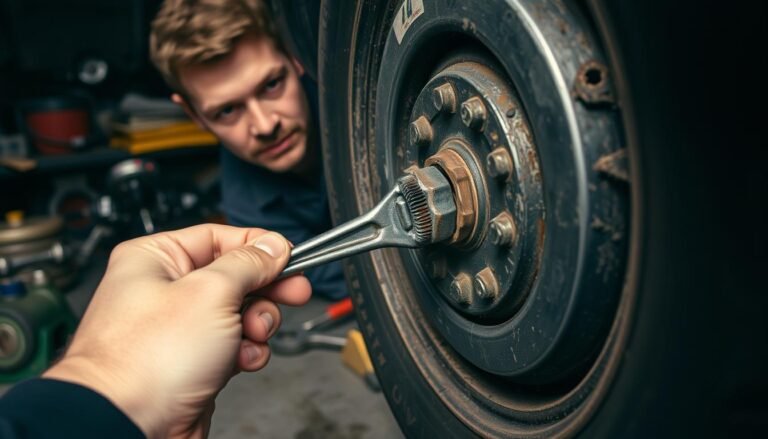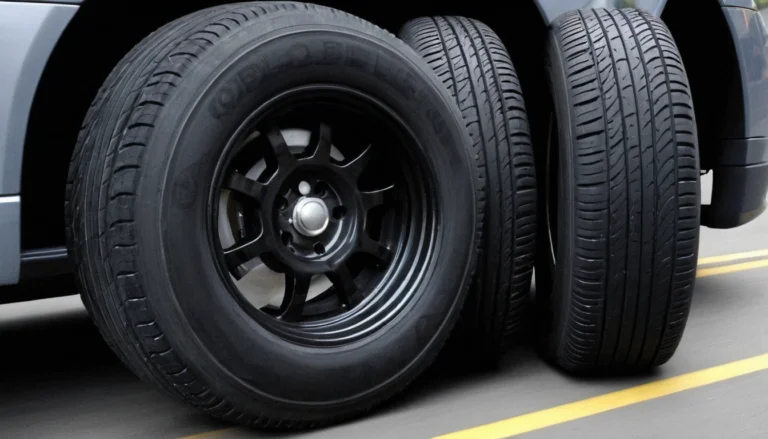How to Know if my Car needs a Wheel Alignment?
Proper wheel alignment is key for your car’s smooth running. Misaligned wheels cause problems like uneven tire wear and poor handling. Spotting the signs early can prevent bigger, more expensive issues.
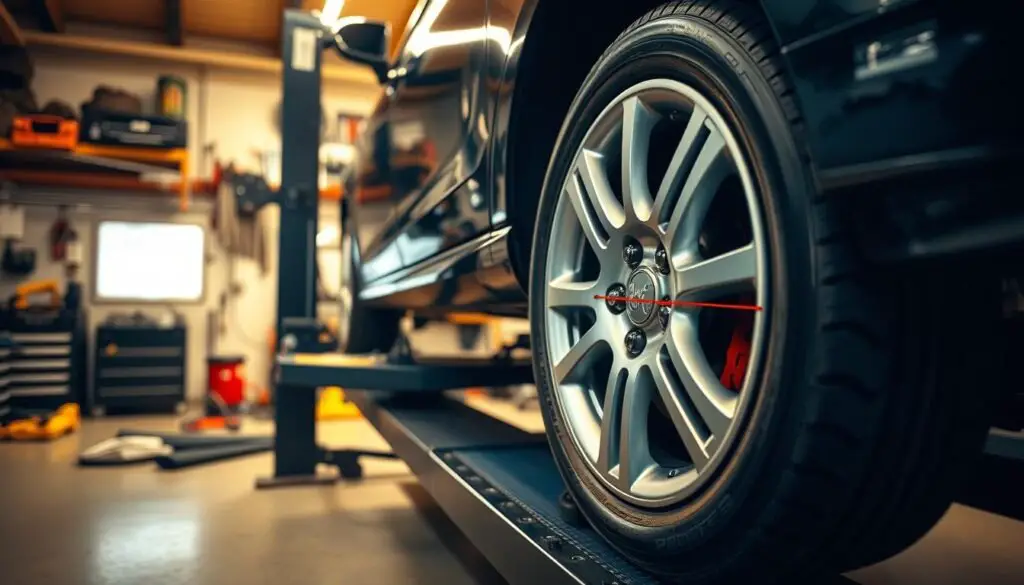
Key Takeaways
- Uneven tire wear is a clear sign that your car’s wheels are misaligned.
- If your vehicle is pulling to one side, it could be a result of improper wheel alignment.
- A crooked steering wheel is another indicator that your wheels need to be realigned.
- Vibrations while driving, especially at high speeds, can be a symptom of wheel misalignment.
- Poor handling and responsiveness are common issues caused by misaligned wheels.
Introduction to Wheel Alignment
Keeping your vehicle’s wheels aligned is key for its performance and safety. Wheel alignment means adjusting the suspension to align the wheels correctly. This ensures the vehicle handles well, stays stable, and tires last longer.
What is Wheel Alignment?
Wheel alignment adjusts a car’s wheels to match the manufacturer’s specs. It involves tweaking the camber, caster, and toe angles. This ensures the wheels work together, reducing wear and boosting performance.
Why is Proper Wheel Alignment Important?
Out-of-alignment wheels cause many problems. They lead to uneven tire wear, poor fuel efficiency, and safety risks. Misaligned wheels make steering hard, cause vibrations, and affect handling. Keeping your wheels aligned is vital for your vehicle’s performance and tire longevity.
| Benefits of Proper Wheel Alignment | Consequences of Misaligned Wheels |
|---|---|
| Improved fuel efficiency Longer tire life Enhanced handling and control Smoother ride | Uneven tire wear Vehicle pulling to one side Increased vibrations Poor fuel economy Compromised safety |
Uneven Tire Wear
Uneven tire wear is a clear sign your car needs a wheel alignment. If one side of your car’s tires is wearing down faster, it means the wheels are not aligned right. Watching the tire wear patterns can show you what’s wrong, like camber or toe wear.
There are many reasons for uneven tire wear, including:
- Improper wheel alignment settings
- Worn suspension components
- Damage to the wheel or tire
- Incorrect tire pressure
Fixing the cause of uneven tire wear can make your tires last longer. It also improves your car’s handling and performance.
Regular wheel alignment checks and quick fixes can stop early tire wear. Being alert to uneven tire wear saves money and keeps your car running well.
Vehicle Pulling to One Side
If your car seems to have a mind of its own, constantly pulling to one side of the road, it’s a strong sign that your wheel alignment needs attention. This issue, known as vehicle pulling, can be caused by various factors. Ignoring it can lead to serious consequences.
Causes of Vehicle Pulling
The most common causes of vehicle pulling include:
- Uneven tire pressure
- Worn suspension components
- Misaligned steering system
When one or more of these issues is present, the vehicle’s wheels may not be properly aligned. This causes it to drift to one side of the road. This is especially noticeable when driving at higher speeds or on straight roads.
Potential Dangers of Ignoring the Issue
Ignoring the issue of vehicle pulling can lead to several dangers, including:
- Increased tire wear: The uneven distribution of weight on the tires can cause premature and uneven wear. This reduces the tire’s lifespan and traction.
- Reduced fuel efficiency: A misaligned vehicle requires more effort to maintain a straight course. This leads to increased fuel consumption and higher operating costs.
- Safety concerns: As the vehicle becomes more difficult to control, the risk of accidents and loss of control increases. This puts both the driver and other road users at risk.
It’s essential to address vehicle pulling promptly to ensure the safety and longevity of your vehicle. Regular wheel alignments can help prevent these issues. They keep your car driving straight and true.
Crooked Steering Wheel
One of the most obvious signs that your car’s wheels are misaligned is a crooked or off-center steering wheel. If the steering wheel is not straight when driving straight, it means the steering wheel alignment is off.
This problem can make driving harder and wear out the steering parts faster. A crooked crooked steering wheel shows your car needs a wheel alignment service.
- A crooked or off-center steering wheel is a clear sign of wheel misalignment.
- It can make the vehicle more challenging to control and cause accelerated wear on steering components.
- Addressing a crooked steering wheel promptly is crucial for maintaining proper vehicle handling and safety.
A properly aligned steering wheel should remain centered and straight when the vehicle is driving in a straight line.
If your steering wheel is no longer centered, it’s time to check your car’s wheel alignment. Ignoring this can cause uneven tire wear and lower fuel efficiency. Don’t wait until it’s too late – fix a crooked steering wheel right away for a better driving experience.
Vibrations While Driving
Vibrations while driving can be annoying and worrying. They often mean your vehicle’s wheel alignment or tire balance is off. Knowing what causes these vibrations helps fix the problem and makes your ride smoother.
Vibrations at Low Speeds
Vibrations at slow speeds might point to wheel bearings or suspension issues. These parts are key for a stable ride. Any trouble with them can cause vibrations, especially when you’re going slow.
Vibrations at High Speeds
Vibrations at fast speeds usually mean misaligned wheels or unbalanced tires. When wheels or tires aren’t right, it leads to uneven weight. This unevenness causes vibrations that get worse as you go faster.
Fixing these vibrations while driving, at low speeds or high speeds, is crucial. It keeps your vehicle safe and reliable. Quick action can stop more damage and make driving more fun.
| Vibration Type | Potential Causes |
|---|---|
| Low-Speed Vibrations | Wheel bearings, suspension components |
| High-Speed Vibrations | Misaligned wheels, imbalanced tires |
Poor Handling and Responsiveness
When your car’s wheels are out of alignment, it can affect how it handles and responds. You might find the car hard to steer, feeling “loose” or slow to react. This can be very dangerous, making it hard to control the car, especially in emergencies.
Poor handling and responsiveness due to wheel misalignment can show up in different ways:
- Difficulty steering the vehicle, with a “wandering” or “drifting” sensation on the road
- Increased body roll or sway when cornering or making sharp turns
- A feeling of the vehicle being “unstable” or “twitchy” at higher speeds
- Decreased responsiveness to the driver’s inputs, leading to a delayed reaction time
These poor handling issues can be both frustrating and dangerous. They make it hard for the driver to control the car. Ignoring these handling problems can make things worse, leading to more poor responsiveness and increased risks on the road.
| Symptom | Potential Cause | Impact on Handling |
|---|---|---|
| Difficulty steering | Worn tie rods, ball joints, or suspension components | Increased steering effort, reduced responsiveness |
| Excessive body roll | Improper tire pressure, worn shocks or struts | Reduced stability and cornering ability |
| Twitchy or unstable feel | Misaligned wheels, worn steering components | Decreased control and driver confidence |
Getting a professional wheel alignment service is key to keeping your car safe and performing well. Ignoring these handling issues can lead to more poor responsiveness and dangerous driving conditions.
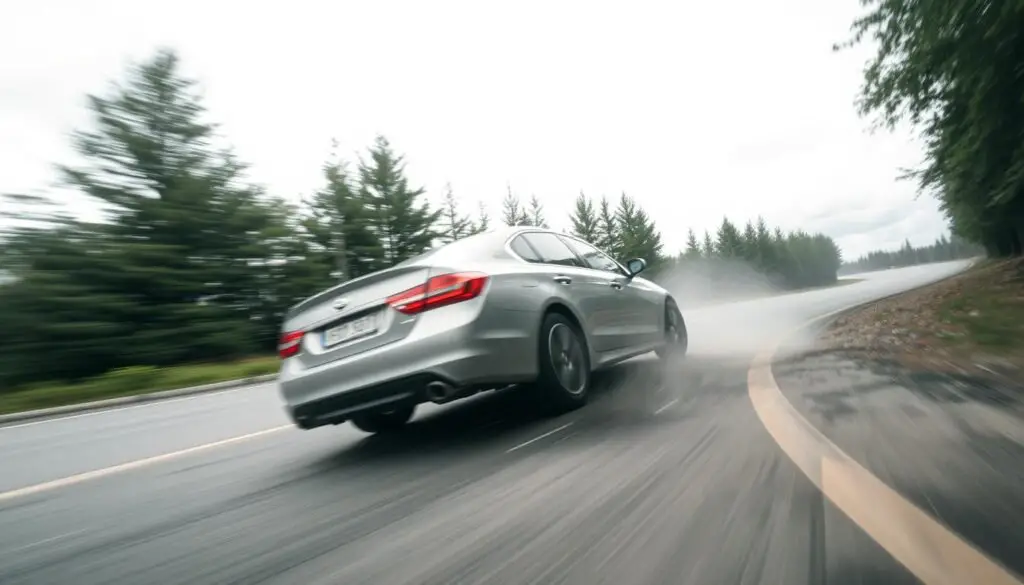
How to Know if My Car Needs a Wheel Alignment?
Wondering if your car needs a wheel alignment? Look out for several signs. These signs can help you fix alignment issues before they get worse.
Uneven tire wear is a clear sign of misalignment. If one tire wears down faster than others, your wheels might not be aligned right. Also, if your car pulls to one side while driving straight, it’s another sign.
A crooked steering wheel that doesn’t straighten after a turn could mean alignment issues. Vibrations while driving, especially at certain speeds, also point to misalignment.
If you notice these problems, get your car checked by a pro right away. Ignoring them can harm your car’s fuel efficiency, tire life, and safety.
“Maintaining proper wheel alignment is crucial for the longevity of your tires and the overall handling and performance of your vehicle.”
Being alert and fixing alignment problems quickly keeps your car safe and efficient. Knowing the signs of wheel alignment issues is key.
Tire Wear Patterns
Looking at your tires can tell you a lot about your car’s alignment. By spotting these patterns, you and your mechanic can find and fix the problems faster.
Camber Wear Pattern
Camber wear shows up as uneven wear on the inside or outside of the tires. This means there’s a problem with how the wheels are tilted. If the wheels are tilted too far out, the outside tires wear down faster. If they’re tilted too far in, the inside tires wear down more.
Toe Wear Pattern
Toe wear happens when the tires wear more on the front or back edges. This is usually because the wheels are not aligned right. If the wheels are not set correctly, the tires rub against the road, causing uneven wear.
Knowing about these wear patterns can really help. It lets you and your mechanic figure out and fix the alignment problems in your car.
Pulling to One Side
If your car seems to have a mind of its own, constantly pulling to one side of the road, it’s a strong sign that your wheel alignment needs attention. This common issue can be caused by various factors, including uneven tire pressure, worn suspension components, or a misaligned steering system.
One of the primary causes of vehicle pulling is a misalignment in the front wheels. When the wheels are not properly aligned, the car will naturally drift towards one direction. This requires the driver to constantly correct the steering to maintain a straight course.
This not only makes the vehicle challenging to control but can also lead to increased tire wear, reduced fuel efficiency, and even safety concerns.
- Uneven tire pressure can cause one side of the vehicle to pull more than the other, as the tires with lower pressure will have less grip and traction.
- Worn or damaged suspension components, such as ball joints, tie rods, or control arms, can also contribute to wheel misalignment and pulling.
- A misaligned steering system, where the steering wheel is not centered properly, can result in the vehicle drifting to one side.
Ignoring a pulling issue can exacerbate the problem, leading to further complications and safety risks. It’s essential to have your vehicle’s wheel alignment checked and adjusted by a qualified technician. This ensures proper handling, improved fuel efficiency, and extended tire life.
“A properly aligned vehicle should drive straight with minimal effort from the driver.”
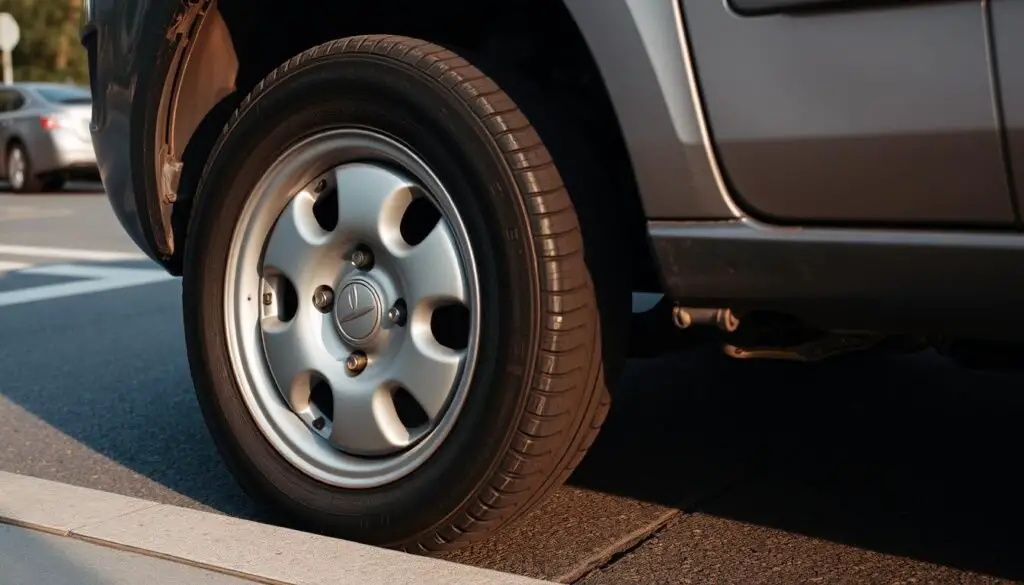
Uneven Tire Tread Depth
Uneven tire tread depth means your vehicle’s wheels might be out of alignment. If one side of your tires is much more worn than the other, it’s a sign of misalignment. Fixing this can make your tires last longer and improve your car’s performance and safety.
Proper wheel alignment keeps your vehicle’s wheels in the right spot. This ensures even weight distribution and smooth handling. But, if the wheels are off, the tire tread depth gets uneven, causing problems:
- One side of the tire wears out faster, shortening its life
- Your car uses more fuel because it has to work harder
- Handling and responsiveness get worse, making the car harder to control
If you see uneven tire tread, get your wheel alignment checked right away. This stops further damage, improves handling, and makes driving safer and more comfortable.
| Symptom | Potential Cause | Recommended Action |
|---|---|---|
| Uneven tire tread wear | Misaligned wheels | Schedule a wheel alignment service |
| Pulling or drifting to one side | Incorrect wheel alignment | Inspect and adjust wheel alignment |
| Vibrations or shaking while driving | Worn suspension components or unbalanced tires | Have a professional inspect the suspension and balance the tires |
Keeping an eye on your vehicle’s wheel alignment and tire tread depth is key. It helps keep your car running well, safely, and for a long time. Fixing problems quickly means your car will keep driving smoothly and reliably.
Poor Fuel Efficiency
Wheel misalignment can really hurt your car’s fuel efficiency. When wheels are not aligned, tires work harder to keep the car straight. This makes them roll less smoothly, using more fuel. This not only costs you money but also harms the environment.
How Wheel Misalignment Affects Fuel Consumption
When wheels are aligned right, your car moves easily, saving fuel. But, if they’re not, tires fight against the misalignment. This fight creates extra friction, leading to poor fuel efficiency. It means you spend more on gas and pollute more.
| Wheel Alignment Status | Fuel Efficiency Impact |
|---|---|
| Properly Aligned | Optimal fuel efficiency |
| Misaligned | Decreased fuel efficiency, increased fuel consumption |
Fixing wheel misalignment can make your car use less fuel and save you money. Regular checks and adjustments keep your car running well. This means better performance and fuel use.
“Proper wheel alignment is essential for maintaining good fuel efficiency and extending the life of your tires.”
Conclusion
Knowing the wheel alignment symptoms and signs of wheel alignment issues is key. It keeps your vehicle running well, safe, and lasts longer. Look out for uneven tire wear, your car pulling, steering wheel problems, and vibrations.
These signs mean your wheels might not be aligned right. Fixing this early can save you money and make driving better. It’s important to check your tires and fix any alignment problems to avoid big repairs.
By watching for these signs, you can fix alignment issues before they get worse. This keeps your car handling well, stable, and efficient. It’s a smart move for any car owner to stay on top of wheel alignment.
FAQ
How do I know if my car needs a wheel alignment?
Signs your car needs a wheel alignment include uneven tire wear and the vehicle pulling to one side. A crooked steering wheel, vibrations while driving, and poor handling are also indicators. Catching these signs early can prevent damage to your vehicle.
What are the symptoms of a wheel alignment problem?
Symptoms include uneven tire wear and the vehicle pulling to one side. A crooked steering wheel, vibrations at any speed, and poor handling are also signs. These issues mean your wheels are not aligned right, affecting your car’s performance and safety.
What are the common tire wear patterns that indicate a wheel alignment issue?
Camber wear shows uneven wear on the inside or outside of the tires, pointing to camber angle issues. Toe wear, with more wear on the front or back edges, suggests toe alignment problems. Checking these patterns helps pinpoint the alignment issue.
How does a poor wheel alignment affect my car’s fuel efficiency?
Poor wheel alignment makes your car use more fuel. Misaligned wheels mean tires work harder, leading to increased rolling resistance and fuel use. Fixing alignment issues can boost your car’s fuel economy and lower costs.
What are the potential dangers of ignoring a vehicle pulling to one side?
Ignoring a vehicle that pulls to one side can cause uneven tire wear and lower fuel efficiency. It also makes driving less safe, as the car may be harder to control. Addressing this issue quickly is crucial for your safety.


